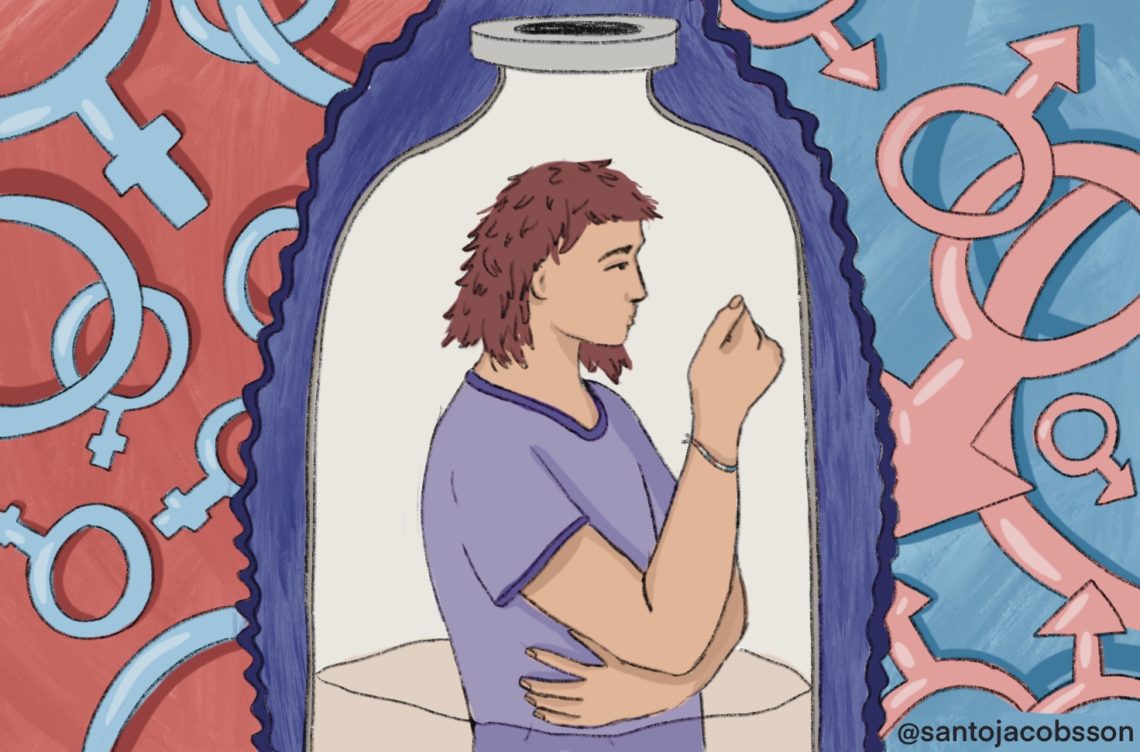Written by: Celeste Trianon (they/them), Trans* Advocate
Edited by: Miles Llewellyn (they/them).
With all the vicious attacks on the rights of transgender and gender-diverse youth around the world, it’s becoming increasingly important to revisit the truth behind puberty blockers and hormone blockers– the lifesaving, reversible drugs used to save trans* youth from the potentially devastating and highly distressing effects of going through a gender dysphoric puberty (1). An alarming amount of disinformation exists surrounding trans* healthcare, especially trans* youth healthcare. Combined with preexisting stereotypes surrounding children and teenagers, notably ones claiming that they aren’t mature enough to make choices concerning themselves, a perfect concoction for systemic exclusion is created. It is paramount to dispel myths and allow reality to sink in.
One may ask, is not providing gender-affirming healthcare an option? The answer is, simply said, no. Going through a gender dysphoric puberty may bring irreversible changes (e.g. size, height, bone structure, deepening of the voice) or changes that require invasive interventions such as surgery or therapy to rectify (e.g. chest/breast tissue development) (2). Interventions such as these can pose many barriers to individuals seeking medical or surgical transition services, such as medical contraindications and cost of procedures. The “neutral” path of non-intervention is a harmful one.
One may ask, is not providing gender-affirming healthcare an option? The answer is, simply said, no.
First, one thing must be clarified: generally speaking, gender-affirming surgeries are not provided to trans* youth. However, this isn’t because of the efforts of transphobic lawmakers; this is because surgeries are, obviously enough, irreversible. When surgeries are provided to trans* youth, this is generally because they have already demonstrated “psychological maturity” (an unfortunately subjective criterion), and have an appropriate sociological and/or psychological reason for pursuing surgery before the age of majority, whether that be due to significant distress from particular body parts or wanting to have “fully transitioned” prior to a major life event or milestone, such as attending college. WPATH (World Professional Association for Transgender Health), an American non-profit organization which publishes the Standards of Care (a controversial set of guidelines which supports but also gatekeeps trans* folx who seek to transition), suggests the use of a three-step approach: beginning with entirely reversible gender-affirming care (e.g. puberty and hormone blockers), before proceeding to semi-reversible care (e.g. hormones), and surgery being advised only once the individual reaches the age of majority (1).
Second, I would like to address the topic of puberty blockers. These are known as GnRH analogues, which are hormones that can be used to completely suppress puberty, regardless of assigned sex. A common puberty blocker, leuprorelin (trade name Lupron), has triggered explosions amongst the far-right misinformation cycle for allegedly “killing thousands of gender-confused [sic] kids” (4). However, these deaths are associated with those diagnosed with prostate cancer who received leuprorelin as a treatment and have been misconstrued to lead people to believe that the leuprorelin played a part in the deaths (5). In reality, very few severe side effects have been reported in Lupron users related to its use as a puberty blocker (6).
On the other hand, hormone blockers such as spironolactone target specific hormone receptors to decrease the effects of circulating testosterone. Hormone blockers are different from puberty blockers in that the former do not stop puberty from occurring, but instead they decrease the potency of a specific hormone (whether estrogen or testosterone). Hormone blockers are often taken with hormones themselves, unlike puberty blockers which are generally taken alone. Hormone blockers haven’t received as much media attention, but this is only because puberty blockers stops puberty from “naturally” occurring, instead of merely mitigating or stopping the effects of the hormones causing gender dysphoria in the individual. Hormone blockers are also entirely reversible, as stopping these drugs will allow puberty (according to one’s gonads) to resume, something which may be desirable (for folx who ultimately do not transition) or highly undesirable (for folx who ultimately do transition) (1).
So, what do healthcare professionals need to know?
1. Puberty and hormone blockers are two different classes of drugs. Puberty blockers completely suppress hormone production (and consequently, puberty) in the entire body, bringing it to a standstill before it can even happen. This is accomplished via the hypothalamic-pituitary-gonadal axis; GnRH analogues shut down estrogen and/or testosterone production by inhibiting FSH and LH. Alternatively, most hormone blockers inhibit hormone receptors; for example, spironolactone blocks androgen receptors, preventing the effects of testosterone without inhibiting its production. Generally speaking, puberty blockers are prescribed to trans* youth before puberty has initiated or to those who are in the early phases of a gender dysphoric puberty (Tanner I-III) whereas hormone blockers (in conjunction with gender-affirming hormones) are prescribed to trans* youth and adults who have already undergone puberty according to one’s gonads (Tanner IV – V) in order to guide them towards more affirmative changes.
2. Both puberty and hormone blockers are safe to prescribe and the benefits significantly outweigh the risks. What so many people fail to realize is that there is a 40% lifetime suicide attempt rate among trans* people and having access to gender-affirming healthcare, which includes access to puberty blockers, hormone blockers, and affirmative hormones, can and will reduce this number significantly (7). Gender-affirming healthcare shouldn’t be treated as something that could merely improve someone’s life; it must be treated as a way of saving someone’s life. These drugs have been used for decades; spironolactone was first discovered to be antiandrogenic in the late 1960s and has been used as a hormone blocker for transfeminine HRT since the 1980s (8, 9). Leuprorelin was approved for use in 1985, and has been used ever since (10). The fact that the far-right only chose to initiate its crusade against these drugs at the same time trans-affirming healthcare became increasingly prevalent (circa 2019), goes to show that these conservative bigots are attempting to foment hate using pseudoscientific claims rather than listening to what the science says.
3. When prescribing puberty blockers, hormones, and/or hormone blockers, please do not practice gatekeeping, reject or invalidate the individual, or expect them to have an exaggerated gender expression (i.e. hyper-feminine or hyper-masculine). Being trans* is something that is specific to the individual, and how one experiences and expresses gender varies from person to person. There is no one way to “correctly” express gender. Informed consent should be the only barrier to obtaining gender-affirming care. Respecting one’s rights to self-determination, autonomy, dignity, privacy, and respect, and giving them the opportunity to thoroughly weigh the benefits and risks of puberty or hormone blockers is an absolute necessity.
This article was written with the intention of demystifying puberty and hormone blockers, often the first stepping stone in the process of medical transition for many trans* youth worldwide. Do not be afraid to discuss the variety of pathways one can take in transitioning; it’s a unique journey which often takes years (or could be a lifelong journey!) and is not an instantaneous transformation.
Note: Trans* is a term used to refer to trans, non-binary and gender-diverse folx.
References:
1. WPATH. WPATH Standards of Care for the Health of Transsexual, Transgender, and Gender Nonconforming People Version 7 In: Fall H, ed. SOC version 72011.
2. Giordano S. Lives in a chiaroscuro. Should we suspend the puberty of children with gender identity disorder? Journal of Medical Ethics. 2008. [cited 2021 Apr 30];34(8):580-584. DOI:10.1136/jme.2007.021097
3. Mahfouda S, Moore JK, Siafarikas A, Hewitt T, Ganti U, Lin A, et al. Gender affirming hormones and surgery in transgender children and adolescents. The Lancet Diabetes & Endocrinology [Internet]. 2018 December. [cited 2021 Apr 26]. DOI:10.1016/S2213-8587(18)30305-X
4. Fitzsimons T. [Internet]. NBC News. A viral fake news story linked trans health care to ‘thousands’ of deaths; 2019 Sep 27 [cited 2021 Apr 26];[about 5 screens]. Available from: https://www.nbcnews.com/feature/nbc-out/viral-fake-news-story-linked-trans-healthcare-thousands-deaths-n1059831
5. Cook T, Sherridan WP. Development of GnRH Antagonists for Prostate Cancer: New Approaches to Treatment. The Oncologist Fundamentals of Cancer Medicine. 2000. [cited 2021 Apr 26];5(2):162-168. DOI:10.1634/theoncologist.5-2-162
6. Federal Drug Administration [Internet]. FDA Adverse Events Reporting System (FAERS) Public Dashboard. 2021 Apr 26 [cited 2021 Apr 26];[about 1 screen]. Available from: https://fis.fda.gov/sense/app/d10be6bb-494e-4cd2-82e4-0135608ddc13/sheet/6b5a135f-f451-45be-893d-20aaee34e28e/state/analysis
7. James SE, Herman JL, Rankin S, Keisling M, Mottet L, Anafi M. [Internet]. The Report of the 2015 U.S. Transgender Survey. National Center for Transgender Equality. Available from: https://transequality.org/sites/default/files/docs/usts/USTS-Full-Report-Dec17.pdf
8. Steelman SL, Brooks JR, Morgan ER, Patanelli, DJ. Anti-androgenic activity of spironolactone. Steroids. 1969. [cited 2021 May 13];14(4):449-450. DOI:10.1016/s0039-128x(69)80007-3
9. Fisher AD, Maggi M. Endocrine Treatment of Transsexual Male-to-Female Persons. Management of Gender Dysphoria. 2015. [cited 2021 May 13];83-91. DOI:10.1007/978-88-470-5696-1_10
10. Fisher J, Ganellin CR. Analogue-based Drug Discovery. 1st ed. Weinheim, Germany: Wiley-VCH; 2006



